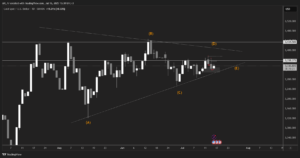Weekly Recap
It was another bearish week for the US Dollar as the greenback continued to sell off from YTD highs. The FOMC meeting minutes, released mid-week, did little to inspire a fresh rally in the Dollar. While the minutes confirmed the Fed’s hawkish stance and reinforced expectations for further 50bps hikes in June and July, there was little in the way of exciting details to get bulls reinvigorated. Additionally, with the Fed having seemingly turned more hawkish since that meeting, the minutes felt a little outdated.
On the data front, a string of weaker-than-expected indicators out of the eurozone heightened growth concerns. With ECB’s Lagarde essentially confirming a July rate-hike, recession fears weighed on European asset markets though EUR itself remained well bid. Elsewhere, equities markets generally saw a choppy week though most indices ended the week in the green, benefitting from the weaker US Dollar.
BOE’s Bailey warned that further rate hikes will likely be necessary in the face of rising inflation. The new fiscal package announced by the UK government this week, aimed at helping households fight rising energy bills, has further increased the likelihood of BOE rate hikes in the near-term.
Commodities prices were higher over the week also. Gold, silver and oil all rallied on the back of a weaker US Dollar. With monetary policy divergence between the Fed and other central banks drying up, USD pressure has helped commodities stay afloat recently.
Coming Up This Week
- Australian GDP
Australian GDP will be closely watched this week on the back of the recent RBA rate hike. With the bank lifting rates and sounding firmly hawkish in its outlook and assessment, this week’s data might further support growing RBA rate hike expectations. With the country having emerged from one of the longest lockdowns of the pandemic, the economy has been on the bounce-back. However, as we have seen elsewhere, the economy has still been rocked by rising inflation and supply constraints. Traders will be keen to see the extent to which these factors weighed on the economy over the last quarter.
- BOC Rate Decision
The BOC is widely expected to raise rates when it convenes for this month’s meeting mid-week. All 30 economists polled by Reuters ahead of the event are looking for a .5% hike. With this in mind, the focus will be on the bank’s forward guidance. If the BOC gives a clear signal that further hikes are coming in the near future, this should drive CAD higher near-term. However, if there is any indication that the BOC might look to hold off on any further rate hikes near-term, this will likely see cad dragged lower.
- US Non-Farm Payrolls
The latest set of US labour market indicators this week will be closely watched as we head to the June meeting. Recent Fed commentary has been decidedly hawkish and it would likely take a major downside shock to change this narrative. Even then, it certainly wouldn’t impact the June rate hike and would likely only factor in forward guidance issued by the Fed. Still, with slowdown fears building, any weakness would no doubt act as a headwind to risk sentiment in the short-term.
Forex Heat Map

Technical Analysis
Our favourite chart this week is the Dollar Index (DXY)
The DXY has pulled back from recent multi-year highs and is now sitting on a make-or-break level at 101.94. This level was the 2020 closing high price. While the level holds as support, DXY is likely to recover and continue the longer-term bull trend. Below here, however, there is room for the correction to develop further towards next support at 100.37

Economic Calendar
Plenty of key data releases to keep an eye on this week including Australian GDP, BOC rate decision and US Non-Farm Payrolls to name a few. Please see full calendar below for the complete schedule.



Disclaimer: This article is not investment advice or an investment recommendation and should not be considered as such. The information above is not an invitation to trade and it does not guarantee or predict future performance. The investor is solely responsible for the risk of their decisions. The analysis and commentary presented do not include any consideration of your personal investment objectives, financial circumstances, or needs.





